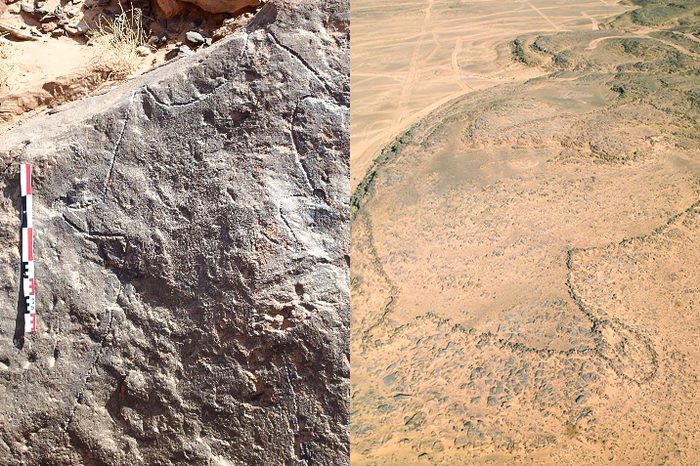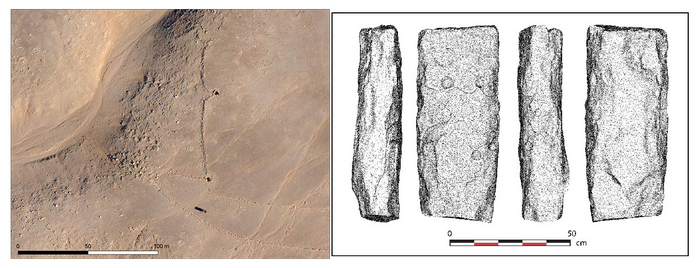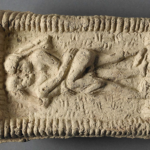Oldest architectural plans detail desert kites, prehistoric mega structures
The oldest scale plans of human made mega structures are reported in the open access journal PLOS ONE on May 17, 2023. The engravings, dated to between 7,000 and 8,000 years old, depict nearby desert kites, vast structures used to trap animals. The ability to transpose large space onto a small, two dimensional surface represents a milestone in intelligent behavior, and boosts understanding of how kites were conceived and built.

Desert kites were first spotted by airplanes in the 1920s. They are sophisticated archaeological structures made up of walls up to 5km long which converge in an enclosure to trap animals bordered by pits. Such structures are visible as a whole only from the air, yet this calls for the representation of space in a way not seen at this time.
Rémy Crassard of CNRS, Université Lyon, and colleagues, report two engravings that represent kites in Jordan and Saudi Arabia. In Jordan, the Jibal al-Khasabiyeh area has eight kites. A stone with a representation carved with stone tools measuring 80 cm long and 32 cm wide was found nearby and dated to around 7,000 years ago. Zebel az-Zilliyat in Saudi Arabia has two pairs of visible kites 3.5km apart. Here a massive to-scale engraving measuring 382 cm long, 235 cm wide was excavated and the depiction was reportedly pecked rather than carved, possibly with hand picks. This was dated to around 8,000 years ago.
Plans like these would have been needed by the constructors as the whole layout is impossible to grasp without seeing it from the air. Until now, evidence for plans of large structures has been seen in rough representations, but these designs are extremely precise.
Although human constructions have modified natural spaces for millennia, few plans or maps predate the period of the literate civilizations of Mesopotamia and Ancient Egypt. These examples are the oldest known plans to scale in human history.
The authors add: “The oldest known plans to scale in human history are reported in our study. The engravings, dated to between 8,000 and 9,000 years old, were discovered in Jordan and Saudi Arabia. They depict nearby desert kites that were humanmade mega structures used to trap wild animals. Although human constructions have modified natural spaces for millennia, few plans or maps predate the period of the literate civilizations of Mesopotamia and Ancient Egypt. The ability to transpose large space onto a small, two dimensional surface represents a milestone in intelligent behavior. Such structures are visible as a whole only from the air, yet this calls for the representation of space in a way not seen at this time.”
Press release from the Public Library of Science.
————————————————————————————————————————————————

Although human constructions have modified natural spaces for millennia, few plans or maps predate the period of the literate civilizations of Mesopotamia and Ancient Egypt. Researchers from the French research organisation “Centre national de la recherche scientifique” (CNRS), together with Prof. Dr. Frank Preusser from the University of Freiburg, have now been able to identify engravings in Jordan and Saudi Arabia as the oldest known true-to-scale construction plans in human history. The 8,000 to 9,000-year-old engravings depict so-called desert kites – kilometre long prehistoric megastructures used to trap animals.
“Conclusions can be drawn from the findings about the people of the time. The ability to transfer a large space to a small, two-dimensional plan represents a milestone in intelligent behaviour,”
explains Preusser. The results, which were published in mid-May in the scientific journal PLoS ONE, should help to understand how desert kites were conceived and built.
Scale plans of desert kites discovered in Jordan and Saudi Arabia
Both finds are representations of nearby desert kites engraved with stone tools. First sighted from aircrafts in the 1920s, desert kites, up to five kilometres long, consist of stone walls that converge in a complex bounded by pits. As archaeologists have been able to determine in recent years, they were used for large-scale trapping of wild animals. In Jordan, there are eight desert kites in the area of Jibal al-Khasabiyeh. There, the researchers found a depiction engraved in stone that measures 80 by 32 cm, its age is about 9,000 years. At Jebel az-Zilliyat in Saudi Arabia, two visible pairs of kites are found three and a half kilometres apart. Here, too, a scaled engraving dating back about 8,000 years was discovered with a total length of 382 cm and a width of 235 cm.
Plans of large structures have so far only been attested by rough representations, in stark contrast to the precision of the engravings of al-Khashabiyeh and az-Zilliyat. The question of their exact use and how they were implemented, especially due to the difficulty of grasping the entire complex from the ground, remains for the time being the secret of the people by whom they were created.

Bibliographic information:
Crassard R., Abu-Azizeh W., Barge O., Brochier J.É., Preusser F., Seba H., Kiouche A.E., Régagnon E., Sánchez Priego J.A., Almalki T., Tarawneh M., 2023. The oldest plans to scale of humanmade mega-structures, PLoS ONE 18(5): e0277927. https://doi.org/10.1371/journal.pone.0277927
Press release from the University of Freiburg.


